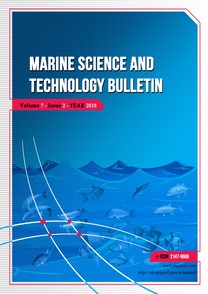Determination of Shellfish Consumption Preferences and Habits in Erzurum Province
The purpose of this research is to determine the shellfish consumption preferences and habits between November 2019 and February 2020 in Erzurum province. A survey consisting of 15 questions was asked face to face with 122 people randomly selected to obtain some results relevant to participant’s average monthly income, educational background, their occupational status. The relationships between the demographic characteristics of the participants and the consumption habits of shellfish were analyzed with the Chi-square test. When demographic data were examined, 46.72% of the participants were female, 53.28% were male. The highest age group with a rate of 41,80% is 21-30 years old, the lowest being 61-70 years old with a rate of 4,92% has been identified as the group. When the education levels of the participants were analyzed, it was determined that the highest rate (60.65%) was belonged to university graduates. According to the result, 83.3% of the participants stated that they had not information about the nutritional value of shellfish. Also, it was determined that 66.2% of the sharers preferred mussels compared to crustaceans. This study in Erzurum, where the consumption of shellfish is very low compared to the seashore cities, is also an important data source in terms of providing ideas for different researches and aquaculture systems.
Keywords:
Erzurum shellfish, consumption preferences,
___
- Anonymous. (2019). Su ürünleri sektör politika belgesi 2019-2023.
- Anonymous, (2020). Erzurum ili. Retrieved on August 20, 2020 from https://tr.wikipedia.org/wiki/Erzurum
- Arslan, M. & İzci, L. (2016) .Antalya İli Su Ürünleri Tüketim Alışkanlıklarının Belirlenmesi. Eğirdir Su Ürünleri Fakültesi Dergisi, 12(1): 75-85. https://doi.org/10.22392/egirdir.246325
- Aydın, A. & Bashimov, G. (2020). Determination of fish consumption habits of consumers: Case study of Mary city, Turkmenistan. Marine Science and Technology Bulletin, 9(2): 118-124. https://doi.org/10.33714/masteb.685436
- Başçınar, N. (2007). Ülkemizdeki kabuklu ve yumuşakça su ürünleri üretimi ve ihracatı. Yunus Araştırma Bülteni, 7(2): 14-17.
- Baysal, A. (2004). Beslenme. 10. Ed., Ankara, Turkey: Hatipoğlu Yayınevi, 566p.
- Beyazbayrak, Z. (2014). Kahramanmaraş ili Merkez ilçede balık tüketim alışkanlıkları. Master Thesis. Kahramanmaraş Sütçü İmam University, Kahramanmaraş, Turkey.
- Karakaya, E. (2020). Erzincan ili balık tüketim alışkanlıklarının belirlenmesi. Menba Kastamonu Üniversitesi Su Ürünleri Fakültesi Dergisi, 6(1): 18-29.
- Karakulak, Y., Arslan, G. & Yanık, T. (2019). Erzurum ili Merkez ilçelerinin su ürünleri tüketim davranışları üzerine araştırmalar. Acta Aquatica Turcica, 16(2): 290-300. https://doi.org/10.22392/actaquatr.669336
- Karaton Kuzgun, N. & Demirbağ, A. (2018). Palu ilçesi balık tüketim alışkanlıklarının belirlenmesi. Uluslararası Palu Sempozyumu Bildiriler Kitabı, Elazığ, Turkey. pp. 205-212.
- Kılıç, E., Soylu, M. & Uzmanoğlu, M. S. (2019). Ardahan ili su ürünleri tüketim alışkanlıklarının belirlenmesi. Turkish Journal of Agriculture - Food Science and Technology, 7(7): 1028-1039. https://doi.org/10.24925/turjaf.v7i7. 1028-1039.2536
- Oğuzhan, P., Angiş, S., Haliloğlu, H. İ. & Atamanalp, M. (2006). Gökkuşağı alabalığı (Oncorhynchus mykiss) filetolarında sıcak tütsüleme sonrası kimyasal kompozisyon değişimleri. Ege Üniversitesi Su Ürünleri Dergisi, 23(1/3): 465-466.
- Orhan, H. & Yüksel, O. (2010). Burdur İli su ürünleri tüketimi anket uygulaması. Süleyman Demirel Üniversitesi, Ziraat Fakültesi Dergisi, 5(1): 1-7.
- Qasim, M., Qasim, S. & Nazir, N. (2020). Factors affecting fish consumption of traditional subsistence fishers in Khyber Pakhtunkhwa, Pakistan. Marine Science and Technology Bulletin, 9(2): 178-187. https://doi.org/10.33714/masteb.744894
- Saka, F. & Bulut, M. (2020). Determination of fish consumption in Çanakkale. Marine Science and Technology Bulletin, 9(1): 7-14. https://doi.org/10.33714/masteb.658093
- Selvi, K., Kandemir, G. & Özdikmenli Tepeli, S. (2019). Determination of factors affecting on the fish consumption habit in rural areas. COMU Journal of Marine Science and Fisheries, 2(2): 132-141.
- Sümbüloğlu, V. & Sümbüloğlu, K. (2019). Bioistatistik. 13. Ed. Ankara, Turkey: Hatiboğlu Publishing. 299 p.
- Telli, Ö. (2018). Denizli ili su ürünleri tüketim alışkanlıkları üzerine bir anket çalışması. Master Thesis. Süleyman Demirel University, Isparta, Turkey.
- Temel, T. (2014). Rize İlinde hanelerin balık tüketimi üzerine etkili olan faktörlerin belirlenmesi. Master Thesis. Atatürk University,Erzurum, Turkey.
- TurkStat. (2018). Fishery Statistics. Turkish Statistical Institute. Retrieved on August 20, 2020, from http://www.tuik.gov.tr
- Tokuşoğlu, Ö. (2016). Kabuklu su ürünleri etleri ve kalite: Midye, istiridye, karides ve yengeç. Retrieved on February 14, 2020 from http://www.gida2000.com/kabuklu-su-urunleri-etleri-ve-kalite-midye-istiridye-karides-ve-yengec.html
- Yavuz, G. G., Ataseven, Z. Y., Gül, U., Gülaç, Z. N. (2015). Su ürünleri tüketiminde tüketici tercihlerini etkileyen faktörler: Ankara ili örneği. Yunus Araştırma Bülteni, 1(5): 73-82.
- ISSN: 2147-9666
- Yayın Aralığı: Yılda 4 Sayı
- Başlangıç: 2012
- Yayıncı: Adem Yavuz SÖNMEZ
